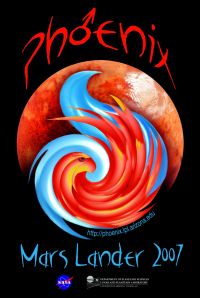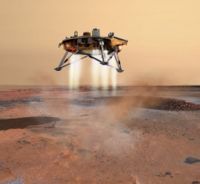Difference between revisions of "Phoenix Mars Mission"
m (updated) |
|||
| Line 13: | Line 13: | ||
[[Image:Sm_140.jpg|thumb|left|200px|An artist's impression of the '''Phoenix lander''''s "powered landing" on touching down on the Mars surface.]] | [[Image:Sm_140.jpg|thumb|left|200px|An artist's impression of the '''Phoenix lander''''s "powered landing" on touching down on the Mars surface.]] | ||
Phoenix was launched on 4th August 2007 on a [[Delta II]] 7925 rocket, and the scheduled landing on Mars on 25th May 2008 was successful. The landing site is the ice-capped northern polar region, and the primary mission is expected to last around 90 [[sol]]s. | Phoenix was launched on 4th August 2007 on a [[Delta II]] 7925 rocket, and the scheduled landing on Mars on 25th May 2008 was successful. The landing site is the ice-capped northern polar region, and the primary mission is expected to last around 90 [[sol]]s. | ||
| + | |||
| + | ==Accomplishments== | ||
| + | Phoenix has confirmed the presence of water ice in the martian soil. | ||
==See Also== | ==See Also== | ||
Revision as of 14:28, 14 October 2008
NASA's Phoenix mission is a robotic mission, the first lander in NASA's "Scout class". The lander landed in Mars' north polar region on May 25th 2008, and the scientific package aims to answer the questions:
- Can the Martian arctic support life?
- What is the history of water at the landing site?
- How is the Martian climate affected by polar dynamics?
The mission name derives from several components built previously for cancelled missions, including 2001's Mars Surveyor lander.
The mission is of considerable interest to planners of human missions to Mars, as many practical mission designs assume the availability of easily-extractable water for fuel production and industrial processes. The polar regions are expected to be the most likely places to find water ice.
Mission Profile
Phoenix was launched on 4th August 2007 on a Delta II 7925 rocket, and the scheduled landing on Mars on 25th May 2008 was successful. The landing site is the ice-capped northern polar region, and the primary mission is expected to last around 90 sols.
Accomplishments
Phoenix has confirmed the presence of water ice in the martian soil.
See Also
The Phoenix Mars Mission (MarsHome.org)








